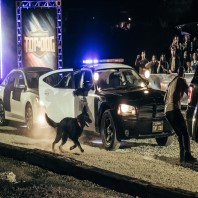All TV shows listed here are U.S.-based TV series. Availability might vary outside of the United States. Show descriptions are from the TV networks. Click on the show’s title to the go to the show’s official website that has air dates and more information.
20/20

ABC News’ “20/20” is an award-winning primetime program. A proven leader as a long-form newsmagazine for over 40 years, “20/20” features unforgettable, character-driven true-crime mysteries, exclusive newsmaker interviews, hard-hitting investigative reports and in-depth coverage of high-profile stories.
Series Premiere: June 6, 1978.
Available on ABC, Hulu.
48 Hours

“48 Hours” is one of the most successful law and justice programs in television history. The enduring appeal of the program is based on original reporting and impact journalism. “48 Hours” has helped exonerate the wrongly convicted, helped solve cold cases, and is committed to investigating the most intriguing and compelling true crime cases. “48 Hours” has been recognized with multiple Peabodys, Emmys, RTNDA Edward R. Murrow Awards and the Alfred I. duPont-Columbia University Award. Erin Moriarty, Peter Van Sant, Maureen Maher, Richard Schlesinger, Tracy Smith are correspondents. Judy Tygard is executive producer, Nancy Kramer is executive story editor.
Series Premiere: January 19, 1988.
Available on CBS, Paramount+, Fubo TV.
911 Crisis Center

This one-of-a-kind documentary series brings viewers behind-the-scenes of the fast-paced, high-stakes world of a dynamic 911 call center outside of Cleveland. This is an up-close and personal look at an amazing team of 911 dispatchers as they take on a never-ending bombardment of panic-stricken callers, and save lives. These dedicated professionals really are the unsung heroes of law enforcement.
Series Premiere: November 6, 2021.
Available on Oxygen, Hulu, Peacock, YouTube TV and FuboTV. Individual episodes available for a price on Prime Video, Google Play, Vudu and YouTube.
Accident, Suicide or Murder

Each hour-long episode retraces the investigation from start to finish, taking viewers through the twists and turns of these shocking cases, from dissecting the red flags to the undeniable evidence, and strange behavior that put the tragedy in question. With the families fighting for justice and the detectives on the case determined to find the truth, motives will be exposed and justice will be served as the families finally find out what caused the death of their loved ones.
Series Premiere: March 23, 2019.
Available on Oxygen, Hulu, Peacock, YouTube TV and FuboTV. Individual episodes available for a price on Prime Video, Google Play, Vudu and YouTube.
Accused: Guilty or Innocent?
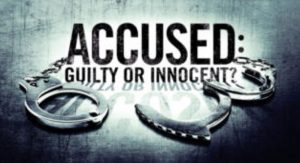
Imagine being accused of a crime, knowing you may spend years in prison. A&E Network’s documentary series “Accused: Guilty or Innocent?” follows the dramatic inside stories—as they unfold—of people facing trial for serious crimes they are alleged to have committed. “Accused: Guilty or Innocent?” offers an intimate account of what happens when someone is formally charged with a crime and sent to trial—all solely from the perspective of the accused, their legal team and family members. Each episode follows the accused person’s journey through the planning of their legal defense, the trial and, ultimately, the verdict. “Accused: Guilty or Innocent?” is produced by Brinkworth Productions. Malcolm Brinkworth and Xander Brinkwork are Executive Producers. Elaine Frontain Bryant, Shelly Tatro and Brad Holcman are Executive Producers for A&E.
Series Premiere: April 21, 2020.
Available on A&E, Hulu, Tubi, Sling TV and Philo. Individual episodes available for a price on YouTube.
American Detective With Lt. Joe Kenda
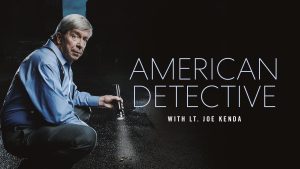
This true-crime series hosted by Lt. Joe Kenda, one of America’s toughest detectives, features incredibly disturbing and mind-blowing cases from across the country. Lt. Kenda expertly guides us through the complex twists and turns of these bizarre crimes.
Series Premiere: January 4, 2021.
Available on Discovery+, Investigation Discovery, Hulu, YouTube TV, Philo and FuboTV. Individual episodes available for a price on Prime Video, Google Play, Vudu and YouTube.
American Greed

Discover multimillion-dollar scams that build unimaginable wealth. Go to places where devious frauds feed deviant desires. And witness the fatal flaws that bring criminals to justice. “American Greed” takes you deep inside shocking true stories of brazen con artists who thrive on stealing fortunes, ruining and even taking lives. In-depth reporting exposes the devastating effects greed has on victims, bringing you up-close to heartless villains living large on other people’s life savings. How do these crooked masterminds defraud the wealthy, rip off their own families, and scam their friends? On “American Greed” (narrated by award-winning actor Stacy Keach), crime pays well, until the crooks get caught. Some people will do anything for money. With evil like this, no one is safe. “American Greed” is produced for CNBC by the independent documentary production company Kurtis Productions, which was formed in Chicago in 1988 by broadcast journalist Bill Kurtis.
Series Premiere: June 21, 2007.
Available on CNBC, Peacock, SlingTV, YouTube TV and FuboTV. Individual episodes available for a price on Prime Video, Google Play, Vudu and YouTube.
American Justice
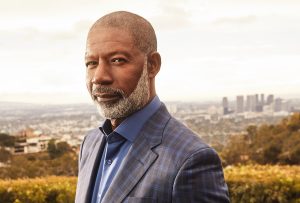
Narrated by actor Dennis Haysbert (“24,” “The Unit,”) the newly reimagined and iconic “American Justice” looks at recent criminal cases in the United States through the prism of the criminal justice system, and from the first-hand perspectives of the prosecutors, defense attorneys, investigators, victims and perpetrators involved. The series dives into significant crimes that were adjudicated within the last few years, from trials that made national headlines to gripping lesser-known cases, ensuring that the issues being explored are relevant. Each story reveals how our justice system works, and, sometimes, how it doesn’t. One of the original true crime documentary series, “American Justice” originally aired for 13 years (1992-2005) on A&E, and was revived in 2021.
Series Premiere: September 15, 1992; August 20, 2021 (reboot)
Available on A&E, A&E Crime Central, Hulu, Tubi, Sling TV and Philo. Individual episodes available for a price on YouTube.
American Monster
Monsters can be found lurking behind any innocent smile and on any street corner in America. Never-before-seen-video footage stares straight into the eyes of these killers who hide in plain sight.
Series Premiere: June 1, 2016.
Available on Investigation Discovery, Discovery+, Hulu, YouTube TV, Philo and FuboTV. Individual episodes available for a price on Prime Video, Google Play, Vudu and YouTube.
Black Market
In his most personal project to date, Michael K. Williams journeys into the dangerous world of illicit trade.
Series Premiere: July 5, 2016.
Available on Vice.
Body Cam

Offering an immersive portrayal of life on the streets, “Body Cam” engages a unique storytelling technique combining the body camera footage with first-hand accounts to virtually place viewers in harrowing moments as the suspense builds and the tension rises. Each episode tells multiple stories of those who vowed to protect and serve in unflinching detail, offering viewers their own personal perspective of officers in life-threatening circumstances. From domestic disputes to ambushes and traffic stops gone dangerously awry, “Body Cam” profiles just how quickly seemingly routine situations can escalate into tragic altercations. Produced by Arrow Media.
Series Premiere: November 27, 2018.
Available on Investigation Discovery, Discovery+, Hulu, YouTube TV, Philo and FuboTV. Individual episodes available for a price on Prime Video, Google Play, Vudu and YouTube.
Buried in the Backyard
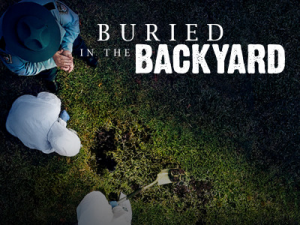
“Buried in the Backyard” examines true-crime stories of victims found hidden in quintessential idyllic spaces. Unearthing the human remains is only the beginning, however, as each hour-long episode focuses on a compelling police investigation that unravels the mystery surrounding the victim’s identity and cause of death. “Buried in the Backyard” is produced by Renegade 83, an Entertainment One company, with Jay Renfroe, David Garfinkle, Bob Kusbit and Carolyn B. Day serving as executive producers. There are also the spinoff series “Buried in the Backyard: Buried in the House” and “Buried in the Backyard: Buried in the Sand.”
Series Premiere: June 3, 2018.
Available on Oxygen, Hulu, Peacock, YouTube TV and FuboTV. Individual episodes available for a price on Prime Video, Google Play, Vudu and YouTube.
Calls From the Inside
It’s an iconic line in any crime story: when a suspect is arrested, they get one call. In reality, once a person enters the criminal justice system, they have multiple opportunities to make calls as they await trial. The vast majority of those calls are recorded. An admission, a threat, a slip of the tongue, a bribe it’s all on tape and the suspect knows it. But this doesn’t always stop them from talking and talking. Calls From the Inside, uses jailhouse phone calls to frame the narrative of murder investigations steeped in mystery.
Series Premiere: December 29, 2021.
Available on Investigation Discovery, Discovery+, Hulu, YouTube TV, Philo and FuboTV. Individual episodes available for a price on Prime Video, Google Play, Vudu and YouTube.
Catching Killers
The investigators behind infamous serial killer cases reveal the harrowing, chilling details of their extraordinary efforts in this true crime series.
Series Premiere: November 4, 2021.
Available on Netflix.
Caught in the Net
What happens when the clues to a murder aren’t just physical, but digital? Caught in the Net presents gripping true stories of investigators entering the digital world to solve a brutal murder. In each case, detectives are up against a lack of physical clues. But every time anyone goes online, whether it’s chat rooms, cellphone apps, car GPS or fitness trackers, they leave a digital trail behind them. Now investigators must enter this virtual world and follow the data, as they race against time to secure justice for victims’ families and track down the killer.
Series Premiere: March 14, 2022.
Available on Investigation Discovery, Discovery+, Hulu, YouTube TV, Philo and FuboTV. Individual episodes available for a price on Prime Video, Google Play, Vudu and YouTube.
Chaos in Court
“Chaos in Court” examines clips of dramatic, unexpected, and cathartic courtroom moments captured in real time. Each hour brings the backstories of the crimes and legal proceedings to the forefront with actual courtroom footage, so shocking, it has to be seen, to be believed. With insightful analysis from a diverse panel of experts including judges, defense attorneys, prosecutors, and criminal psychologists, “Chaos in Court” takes you into the proceedings analyzing each case from start to finish. Featured within each of the ten episodes are interviews with defendants, family members, and others who witnessed the action to help bring dramatic courtroom moments to life, and the emotional realities of what happens when the ultimate stakes are on trial.
Series Premiere: September 18, 2020.
Available on Investigation Discovery, Discovery+, Hulu, YouTube TV, Philo and FuboTV. Individual episodes available for a price on Prime Video, Google Play, Vudu and YouTube.
City Confidential
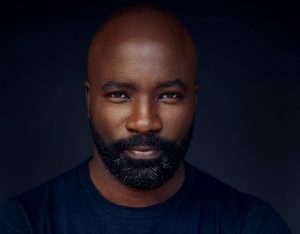
“City Confidential” returns to explore crimes that have impacted cities and towns across America. The iconic, noir-style series goes beyond the headlines to showcase the emotional and unexpected stories that catapulted unique communities, both large and small, into the public eye. Narrated by actor Mike Colter, “City Confidential” tells the story of one crime, the ensuing investigation, and the ripple effect it had on a community. Speaking with family, friends, detectives, journalists, and others close to the case, the series weaves together firsthand accounts and archival footage to explore the crime and its outcome.
Series Premiere: November 7, 1998; October 28, 2021 (reboot)
Available on A&E, A&E Crime Central, Hulu, Tubi, Sling TV and Philo. Individual episodes available for a price on YouTube.
Cold Case Files

There are over 100,000 cold cases in America, and only about 1% are ever solved. With recent advancements in technology and the methods used to solve these cases, as well as the unwavering dedication of victims’ families, law enforcement and the public, “Cold Case Files” explores the cases the defied the odds. Narrated by the original host and producer of “Cold Case Files,” celebrated veteran journalist and newsman Bill Kurtis, each episode of the Emmy-nominated series examines the twists and turns of one murder case that remained unsolved for years, and the critical element that heated it up, leading to the evidence that finally solved it. Featuring interviews with family members, friends, detectives, and others close to the cases, the refreshed classic series examines all facets of the crime and shines a light on a range of voices and victims.
Series Premiere: January 1, 1999; February 27, 2017 (reboot); August 20, 2021 (reboot)
Available on A&E, A&E Crime Central, Hulu, Tubi, Sling TV and Philo. Individual episodes available for a price on YouTube.
Cold Justice
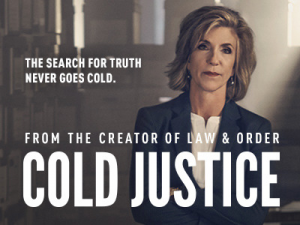
From executive producer Dick Wolf and Magical Elves, the real-life crime series follows veteran prosecutor Kelly Siegler, who gets help from seasoned detectives—Johnny Bonds, Steve Spingola, Aaron Sam and Tonya Rider—as they dig into small town murder cases that have lingered for years without answers or justice for the victims. Together with local law enforcement from across the country, the “Cold Justice” team has successfully helped bring about 30 arrests and 16 convictions. No case is too cold for Siegler as the new season delves into new unsolved homicides while also bringing updates to previous cases. “Cold Justice” is produced by Wolf Reality & Magical Elves with Dick Wolf and Tom Thayer serving as executive producers for Wolf Reality and Jane Lipsitz, Dan Cutforth, Kelly Siegler, Nan Strait and Scott Patch serving as executive producers for Magical Elves.
Series Premiere: September 3, 2013.
Available on TNT (2013-2015); Oxygen, Hulu, Peacock, YouTube TV and FuboTV (2017-present); Individual episodes available for a price on Prime Video, Google Play, Vudu and YouTube.
Court Cam

A&E Network takes viewers inside America’s courtrooms in the new series “Court Cam” executive produced by Law&Crime Productions and Dan Abrams, former host of A&E’s “Live PD” and chief legal analyst for ABC News. This eight-episode 30-minute series gives viewers a front row seat to some of the most wild, unruly and outrageous courtroom moments recently caught on tape.
Series Premiere: December 5, 2019.
Available on A&E, A&E Crime Central, Hulu, Tubi, Sling TV and Philo. Individual episodes available for a price on YouTube.
Crimes Gone Viral
“Crimes Gone Viral” explores the riveting stories behind shocking crimes caught on camera that gain viral fame on the internet. From business security cameras to home surveillance systems and cell phone cameras, someone is almost always watching. Gripping clips of kidnappings, break-ins, wild car chases, violent road rage incidents and other crimes rack up millions of views. But “Crimes Gone Viral” goes beyond the jaw-dropping footage to tell the full story. This series features compelling interviews and behind-the-scenes information of some of the internet’s most viral crime clips.
Series Premiere: September 9, 2020.
Available on Investigation Discovery, Discovery+, Hulu, YouTube TV, Philo and FuboTV. Individual episodes available for a price on Prime Video, Google Play, Vudu and YouTube.
Crime Scene Confidential

In her 12 years as a Crime Scene Investigator for Orange County, Florida, C.S.I Alina Burroughs investigated some of the most startling and devastating cases in the country – from the tragic 2008 death of toddler Caylee Anthony to the 2016 Pulse nightclub massacre. Through her work she has learned that people may not always tell the truth, but the forensic evidence never lies. In this gripping ID series, Burroughs revisits controversial and shocking murder cases from across the country, taking a fresh look at the forensic evidence with the hope to bring more clarity to these complex crimes and closure to those the victims left behind.
Series Premiere: March 8, 2022.
Available on Investigation Discovery, Discovery+, Hulu, YouTube TV, Philo and FuboTV. Individual episodes available for a price on Prime Video, Google Play, Vudu and YouTube.
The Crimes That Changed Us
Certain cases are seared into the American consciousness. They are a part of how we look at society, good and evil. But what would happen if we could go back in time, or back in crime, and look again? This unique series fully re-immerses the viewer in these cases as we experienced them at the time by pairing the best news archive with audio interviews, reintroducing these cases from a new standpoint. Each episode shows the evolution of how these cases were perceived by the public then and how we view them now, exposing how the times have changed, and revealing the lessons learned from each case.
Series Premiere: November 11, 2020.
Available on Investigation Discovery, Discovery+, Hulu, YouTube TV, Philo and FuboTV. Individual episodes available for a price on Prime Video, Google Play, Vudu and YouTube.
Dateline

“Dateline” is NBC’s signature newsmagazine, bringing viewers storytelling at its best. The stories range from compelling mysteries to powerful documentaries and in-depth investigations. When major news breaks, they go to the scene, putting the pieces together to bring the viewer the full picture. And in every story they tell, they help the real people who lived the events share their journeys with the viewer. On the air since 1992, “Dateline” is the longest-running prime-time program on NBC. “Dateline’s” work has been honored time and again with broadcast journalism’s highest awards. Lester Holt is the principal anchor, joined by correspondents Andrea Canning, Hoda Kotb, Josh Mankiewicz, Keith Morrison and Dennis Murphy.
Series Premiere: March 31, 1992.
Available on NBC, Peacock, SlingTV, YouTube TV and FuboTV. Individual episodes available for a price on Prime Video, Google Play, Vudu and YouTube.
Dateline: Secrets Uncovered
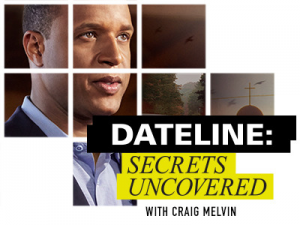
“Dateline: Secrets Uncovered,” hosted by Craig Melvin, explores chilling stories through first-hand accounts, told by those closest to the issue, including investigators entrusted with cracking the case and the families confronting tragedy.
Series Premiere: July 21, 2017.
Available on Oxygen, Hulu, Peacock, YouTube TV and FuboTV. Individual episodes available for a price on Prime Video, Google Play, Vudu and YouTube.
Deadly Women

Hell hath no fury like a woman scorned, especially when she’s on a mission to murder. There’s no shortage of these tempestuous “Deadly Women,” Investigation Discovery’s signature hit series about women who have been driven to kill. Jealousy, revenge, desperation, and greed all play their devilish hand in driving these daughters, sisters, mothers, and wives to commit the ultimate sin. While male murderers are often motivated by anger, impulse, and destruction, women usually have more complex, long-term motives. Former FBI criminal profiler Candice DeLong helps viewers distinguish between the emotionally charged impulses and sociopathic intentions that lace each story.
Series Premiere: February 8, 2005 (as a limited series); December 24, 2008 (as a regular series).
Available on Investigation Discovery, Discovery+, Hulu, YouTube TV, Philo and FuboTV. Individual episodes available for a price on Prime Video, Google Play, Vudu and YouTube.
Dead Silent
Deep in the woods, inside an abandoned house, or along the shores of a sleepy lake, every snap of a twig or unidentified rustle can be a sign of danger. “Dead Silent” shows just how dark and desolate the great outdoors can be when no one can reach you, where myth, urban legend, and horror movie dread collide to showcase twisted tales too frightening to be imaginary. Each hour-long episode features one spine-tingling and terrifying true story, interwoven with expert commentary from local authorities, true-crime experts, and psychologists, as well as first-person accounts from many of the victims who survived these nightmarish events.
Series Premiere: October 25, 2016.
Available on Investigation Discovery, Discovery+, Hulu, YouTube TV, Philo and FuboTV. Individual episodes available for a price on Prime Video, Google Play, Vudu and YouTube.
Devoured
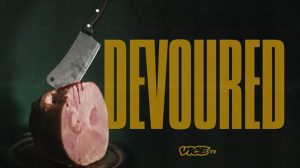
Each one-hour episode of “Devoured” is a deep dive into a single true crime story that centers on one American city or region’s food specialty. Viewers will be taken through a thrill-ride of twists and turns as narrator Jon Cryer uncovers the unbelievable stories of how food fuels criminal enterprises, both large and small. Along the way, the series dishes up the food’s origin story and impact on the culinary landscape—while revealing how our passion for eating well can become a recipe for doing wrong.
Series Premiere: February 21, 2022.
Available on Vice.
Evil Lives Here

What if the person closest to you was a devil in disguise—would you see the signs? Investigation Discovery’s original series “Evil Lives Here” explores the true, heart-stopping stories of people who shared a home and a life with a loved one who would become a killer. “Evil Lives Here” has exclusive interviews and never-before-told accounts of the years and critical moments leading up to these vicious acts, “Evil Lives Here” showcases the devastating and often undiscussed consequences on the people who have nurtured, loved and raised a murderer.
Series Premiere: January 17, 2016.
Available on Investigation Discovery, Discovery+, Hulu, YouTube TV, Philo and FuboTV. Individual episodes available for a price on Prime Video, Google Play, Vudu and YouTube.
Family Massacre
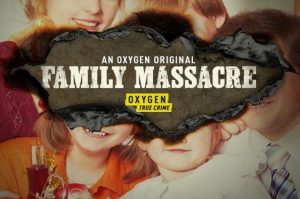
“Family Massacre” is a gripping and powerful exploration of some of the most ruthless murders ever committed. This series follows the true and gruesome tales of the unthinkable: multiple members of the same family slain in cold blood. In each episode, we hear from friends and surviving relatives, those people closest to the family that was massacred, while also detailing the work of the dedicated investigators and prosecutors tasked with finding their killer and bringing them to justice. Through first-hand accounts, archival footage and cinematic recreations, we see the twists and turns of the investigation unfold and delve deep into who could have committed such a shocking crime and just how they were caught and made to answer for it.
Series Premiere: December 3, 2021.
Available on Oxygen, Hulu, Peacock, YouTube TV and FuboTV. Individual episodes available for a price on Prime Video, Google Play, Vudu and YouTube.
Fatal Attraction
Each pulse-pounding hour-long episode of “Fatal Attraction” centers around an incredible and dangerous romance. Shocking crime, kidnapping or even murder is only half of the story. Driven by powerful, real-life stories, “Fatal Attraction” weaves together intimate, first-person interviews, exclusive interrogation footage and rare archival material. Listen as the key players, family of the survivors and those that investigated the horrific crimes reveal the secrets to each sordid tale.
Series Premiere: June 3, 2013.
Available on TV One, Philo.
The FBI Declassified
“The FBI Declassified” features FBI agents and analysts taking viewers behind the scenes of some of the biggest cases they’ve solved during their careers. Through never-before-seen footage and in-depth interviews, each episode will focus on a different investigation and showcase the cooperation between the FBI and other law enforcement agencies. Agents and analysts reveal the thinking, teamwork, technology, techniques and pure gut instinct that goes into solving a critical case. The show’s narrator is Alana De La Garza, star of CBS’s “FBI” drama series.
Series Premiere: October 6, 2020.
Available on CBS, Paramount+, YouTube TV and FubuTV.
The First 48
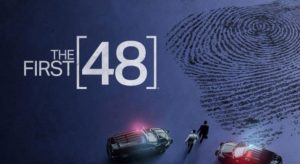
The biggest enemy for any homicide detective is not the suspect…it’s the clock. In fact, if they don’t find a lead in the first 48 hours, their chances of catching the killer are cut in half. The “First 48” tracks real homicide detectives as they struggle to solve murder cases across the country. Gripping, authentic and dramatic, viewers are brought along for the ride as the detectives hunt for killers to bring to justice.
Series Premiere: June 3, 2004.
Available on A&E, A&E Crime Central, Hulu, Tubi, Sling TV and Philo. Individual episodes available for a price on YouTube.
Forensic Files II
Long considered the gold standard of crime docuseries, “Forensic Files” returned after an eight-year production hiatus, now produced by CNN Development for HLN under the guidance of executive producer Nancy Duffy. “Forensic Files II” continues the franchise, featuring the amazing work of scientists and investigators who use cutting edge forensics to crack the most baffling criminal cases. Acclaimed film, stage and television actor Bill Camp (“Dark Waters,” “Joker,” “The Night Of”) is the narrator.
Series Premiere: February 23, 2020.
Available on HLN, CNN.com and Hulu.
For My Man
“For My Man” is a true-crime series that features the salacious and shocking stories of women who have been arrested for a crime they did in the name of love. From a killing spree across the mid-west to being an inside informant at the DEA and from murdering an unsupportive mother to robbing fifteen banks in under a year, these women have no limits as to how far they’ll go for their men. And do not be misled; these are not the women you’d expect. They are straight-A students, career police officers and once happily married women. These are the stories of the obsessions and weakness that fueled their fall from grace.
Series Premiere: November 16, 2015.
Available on TV One, Philo.
Homicide City
“Homicide City” takes a deep dive into the crimes that shook Philadelphia to its core. The series explores cases from a darker time that had police detectives banding together across the metropolitan landscape in a sequence of manhunts. From the mansions of the wealthy suburbs to the rowhouse-lined streets of the inner city, each episode is told through the eyes of veteran homicide detectives, local beat reporters and the victims’ families who lost so much.
Series Premiere: January 1, 2018:
Available on Investigation Discovery, Discovery+, Hulu, YouTube TV, Philo and FuboTV. Individual episodes available for a price on Prime Video, Google Play, Vudu and YouTube.
Homicide for the Holidays

The holiday season is usually the busiest and happiest time of the year and spent with family and friends, but unfortunately can leave a painful surprise when it begins with a shocking murder. Each hour-long episode examines a devastating case as police investigate and go to incredible lengths to unveil secrets about the true motive of the killer, giving families justice about their loved ones’ death. With firsthand accounts from those close to the victim, the limited series delves into the alarming cases that prove the holidays can turn the happiest time of the year upside down in a split second.
Series Premiere: December 3, 2016.
Available on Oxygen, Hulu, Peacock, YouTube TV and FuboTV. Individual episodes available for a price on Prime Video, Google Play, Vudu and YouTube.
How It Really Happened With Hill Harper
Hosted by lauded actor Hill Harper (“The Good Doctor,” “CSI: NY”), “How It Really Happened With Hill Harper” delves deeply into some of the most notorious crimes, mysteries, trials and celebrity tragedies of our time, with enlightening interviews and access to the vast CNN news library. Nancy Duffy is executive producer of the HLN Original Series “How It Really Happened with Hill Harper.”
Series Premiere: January 17, 2017.
Available on HLN, CNN.com and Hulu.
I Am a Killer
Death row inmates convicted of capital murder give firsthand accounts of their crimes in this documentary series.
Series Premiere: August 3, 2018.
Available on Netflix.
I Lived With a Killer
Their lives are portrayed in movies, TV shows and books and their shocking acts are woven into the fabric of scary stories about real monsters in the world. But what happens when the monster is someone you live with and love? Every hour-long episode of “I Lived with a Killer” brings a haunting new twist to cases that terrified the public with the powerful stories from the family members of killers. Viewers will also hear from members of the victims’ families, detectives on each case and experts who break down the media frenzy around the crimes. “I Lived with a Killer” is produced by Breakthrough Entertainment.
Series Premiere: January 25, 2019.
Available on Reelz.
I Survived a Serial Killer
“I Survived a Serial Killer” documents the harrowing, heroic stories of one or more survivors of the same serial killers. Told from the survivors’ point of view, the series highlights the strength and perseverance of regular people encountering and overcoming pure evil. Interviews with those closest to the cases will round out the stories of these unimaginable crimes.
Series Premiere: December 5, 2019.
Available on A&E, A&E Crime Central, Hulu, Tubi, Sling TV and Philo. Individual episodes available for a price on YouTube.
Impact of Murder

Putting the victim at the forefront, Investigation Discovery’s “Impact of Murder” utilizes the emotionally gripping victim’s impact statement delivered in court as the driving storytelling technique. Through a victim’s own words, viewers understand the horror they endured or the significance of the life that was taken, providing an acute understanding of the collateral damage of murder. Impact statements act as a source of strength for those who may feeling helpless after a senseless tragedy, showcasing the empowerment that they feel when they stand up in court to address the perpetrator.
Series Premiere: July 14, 2019.
Available on Investigation Discovery, Discovery+, Hulu, YouTube TV, Philo and FuboTV. Individual episodes available for a price on Prime Video, Google Play, Vudu and YouTube.
In Ice Cold Blood
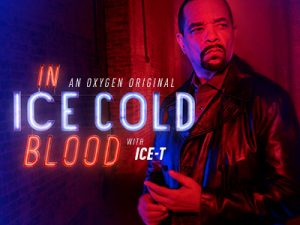
Grammy and NAACP Image Award winner Ice-T (“Law & Order: Special Victims Unit”) is host and executive producer, using his distinct voice to guide viewers through shocking true stories involving sex, money, obsession – or a fatal cocktail of all three. With in-depth interviews and archival footage, each hour-long episode spotlights a shocking mystery characterized by expert detective work, unforeseen twists and jaw-dropping discoveries. When some of the most basic human desires—sex and money—cloud our judgment with lust and greed, they run the risk of dangerous consequences. “In Ice Cold Blood” is produced by The Content Group with Steven Michaels, Jonathan Koch, Brian Knappmiller, and Ryann Lauckner serving as executive producers, along with Final Level Entertainment with Ice-T and Jorge Hinojosa serving as executive producers.
Series Premiere: April 1, 2018.
Available on Oxygen, Hulu, Peacock, YouTube TV and FuboTV. Individual episodes available for a price on Prime Video, Google Play, Vudu and YouTube.
Injustice With Nancy Grace

Legal analyst Nancy Grace gets to the bottom of some of the most challenging and multi-layered true crime stories. Each episode of “Injustice With Nancy Grace” will expose an untold and riveting case involving wrongful accusations, botched investigations, suppressed evidence, unclear motives, unjust sentences and the path forward in seeking justice. “Injustice With Nancy Grace” is produced by The Intellectual Property Corporation, an Industrial Media company, in conjunction with KT Studios and TAP INc., with Eli Holzman, Aaron Saidman, Nancy Grace, John Terenzio, Stephanie Lydecker and showrunner Steve Katz serving as executive producers.
Series Premiere: July 13, 2019.
Available on Oxygen, Hulu, Peacock, YouTube TV and FuboTV. Individual episodes available for a price on Prime Video, Google Play, Vudu and YouTube.
In Pursuit With John Walsh

“In Pursuit With John Walsh” unites the power of Investigation Discovery’s dedicated fanbase with John Walsh’s lifelong mission of putting fugitives behind bars, finding missing children, and empowering the public to assist law enforcement. Showcasing time-sensitive, unsolved cases in desperate need of attention, this new real-time investigation series mobilizes ID’s audience to actively engage in the pursuit of justice. Backed by decades of victim advocacy with a mission stemming from his own personal tragedy, “In Pursuit With John Walsh” utilizes Walsh’s unique and unrivaled experience in this field coupled with a call center able to help law enforcement find leads in real time.
Series Premiere: January 16, 2019.
Available on Investigation Discovery, Discovery+, Hulu, YouTube TV, Philo and FuboTV. Individual episodes available for a price on Prime Video, Google Play, Vudu and YouTube.
I Was a Teenage Felon
“I Was a Teenage Felon” tells some of the most brazen stories of youthful ambition gone haywire as “average American kids” become smugglers, dealers, hackers, scammers and thieves.
Series Premiere: September 22, 2020.
Available on Vice.
Judgment With Ashleigh Banfield

“Judgment With Ashleigh Banfield” is an original series hosted by original Court TV alum and respected former CNN and MSNBC legal analyst Ashleigh Banfield, who made her Court TV return as a special contributor in 2020. “Judgment With Ashleigh Banfield” is a weekly hour-long series taking viewers on a deep dive into the most provocative and talked about trials and cases of all-time. With brand-new interviews and exclusive first-time ever reveals, each installment looks to further explore everything people only thought they knew about these touchstones in judicial history.
Series Premiere: September 13, 2020.
Available on Court TV.
Kids Behind Bars: Life or Parole
“Kids Behind Bars: Life or Parole” tells the individual stories of eight previously convicted child offenders sentenced to mandatory life terms, without parole, who are now seeking resentencing on the heels of a recent United States Supreme Court ruling. While some may be resentenced to life, others could be immediately released or given a new sentence that makes them eligible for parole.
Series Premiere: April 30, 2019.
Available on A&E, A&E Crime Central, Hulu, Tubi, Sling TV and Philo. Individual episodes available for a price on YouTube.
Killer Motive

“Killer Motive,” from the producers of NBC’s “Dateline,” is hosted by two award-winning journalists, NBC News correspondent Stephanie Gosk and Emmy Award winner Troy Roberts. Each hour-long episode uncovers dark and twisted motives, from vengeance to jealousy to greed that led to gruesome killings. “Killer Motive” is produced by NBC News’ award-winning production arm Peacock Productions with Paul Ryan serving as executive producer and Alexa Danner as co-executive producer.
Series Premiere: July 11, 2019.
Available on Oxygen, Hulu, Peacock, YouTube TV and FuboTV. Individual episodes available for a price on Prime Video, Google Play, Vudu and YouTube.
Killer Relationship With Faith Jenkins
“Killer Relationship with Faith Jenkins” investigates burgeoning romances from their sweet beginnings, and follows what happened all the way through to their bitter endings. With her background as a criminal prosecutor in the Manhattan District Attorney’s Office, and with her expertise in matters of the heart, Faith Jenkins gives her professional POV of the nightmarish cases. With first-hand accounts from victims’ family, friends and law enforcement, each hour-long episode reveals the inner workings of intimate attachments that seemed fated to last forever and ended in murder.
Series Premiere: January 16, 2022.
Available on Oxygen, Hulu, Peacock, YouTube TV and FuboTV. Individual episodes available for a price on Prime Video, Google Play, Vudu and YouTube.
Killer Siblings

“Killer Siblings” tells the twisted stories of some of the most maniacal siblings in history. Each hour-long episode explores the psychology and pasts of cold-blooded siblings who have carried out vicious murders. Through exclusive interviews and firsthand accounts, the series delves into the evil minds of siblings who partnered together to commit some of the most heinous and sophisticated homicides. “Killer Siblings” is produced by Scott Sternberg Productions with Scott Sternberg and Matthew Watts serving as executive producers.
Series Premiere: October 27, 2019.
Available on Oxygen, Hulu, Peacock, YouTube TV and FuboTV. Individual episodes available for a price on Prime Video, Google Play, Vudu and YouTube.
License to Kill
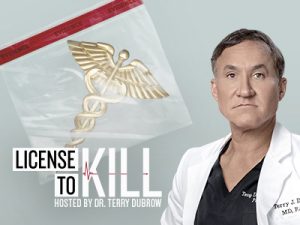
Hosted by renowned plastic surgeon Dr. Terry Dubrow (“Botched”), “License to Kill” chronicles the harrowing accounts of patients put into jeopardy by medical professionals’ insidious use of their expertise. Told from the perspective of victims, families, colleagues and law enforcement, each episode of “License to Kill” exposes what happens when the hands that should heal are used to cause harm on patients at the most vulnerable times. “License to Kill” is produced by Shed Media with Pam Healey, Dan Peirson, Adam Kassen, Haylee Vance, Dave Kuba and Terry Dubrow serving as executive producers.
Series Premiere: June 23, 2019.
Available on Oxygen, Hulu, Peacock, YouTube TV and FuboTV. Individual episodes available for a price on Prime Video, Google Play, Vudu and YouTube.
Lies, Crime & Video
“Lies, Crimes & Video” gives viewers an intimate look into terrifying 911 calls, police interrogations, jail house recordings, body camera and surveillance video captured as part of a criminal investigation. This series features riveting stories that incorporate video evidence in criminal cases and shocking courtroom testimony. The lies, deceit and bad behavior are all caught on camera and presented in this candid true crime docuseries. Produced by HLN Investigations, Elizabeth Yuskaitis is the executive producer.
Series Premiere: June 8, 2019.
Available on HLN, CNN.com and Hulu.
Locked Up Abroad
“Locked Up Abroad” is a cult cable favorite known for taking viewers inside accounts of capture, incarceration and terror far away from home with intimate personal interviews and dramatic reenactments. Hear the firsthand accounts not only of those who were locked up but also of those who were directly part of the story, such as the undercover agent compiling the evidence against the suspect or the person making the drug dealing offers.
Series Premiere: July 24, 2007.
Available on National Geographic Channel, Hulu, ABC. Individual episodes available for a price on Prime Video, Google Play, Vudu and YouTube.
Individual episodes available for a price on Prime Video, Google Play, Vudu and YouTube.
Murder in the Heartland
Middle American towns are explored through the murders that tore through them. The townspeople not only become storytellers, they also hold clues to the puzzle that forever changed their lives and how they understand their home.
Series Premiere: November 29, 2017.
Available on Investigation Discovery, Discovery+, Hulu, YouTube TV, Philo and FuboTV. Individual episodes available for a price on Prime Video, Google Play, Vudu and YouTube.
The Murder Tapes
Homicide investigations unfold through dramatic real footage in this groundbreaking series. Viewers get an up-close perspective of each case using raw, unfiltered footage from body cams at the crime scene, surveillance cameras and interrogation room video.
Series Premiere: August 28, 2019.
Available on Investigation Discovery, Discovery+, Hulu, YouTube TV, Philo and FuboTV. Individual episodes available for a price on Prime Video, Google Play, Vudu and YouTube.
Murder Under the Friday Night Lights
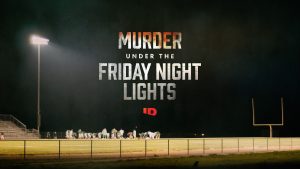
Across the country, high school football unites small-town communities. But when a heinous murder shatters that Friday night dream world, the crime ripples beyond those immediately impacted, and the community will never be the same again.
Series Premiere: January 24, 2022.
Available on Investigation Discovery, Discovery+, Hulu, YouTube TV, Philo and FuboTV. Individual episodes available for a price on Prime Video, Google Play, Vudu and YouTube.
New York Homicide
Oxygen, the home for high quality true crime programming, is diving deep into some of the most chilling murder cases in New York City’s recent history. New York is a shining beacon of opportunity to people across the world, and the convergence of almost innumerable cultures, customs and languages, makes it a true melting pot. It’s a city with a gritty core, where tensions run high. The series, from Good Caper Content, details the brazen crimes that could only happen in New York and the intense work by law enforcement and civilians who race to take murderers off the streets.
Series Premiere: January 1, 2022.
Available on Oxygen, Hulu, Peacock, YouTube TV and FuboTV. Individual episodes available for a price on Prime Video, Google Play, Vudu and YouTube.
On the Case With Paula Zahn

“On the Case With Paula Zahn” takes viewers on an exciting journey inside the most fascinating crime and mystery investigations. First person accounts, along with insight from experts are featured as each case reaches its dramatic conclusion.
Series Premiere: October 18, 2009.
Available on Investigation Discovery, Discovery+, Hulu, YouTube TV, Philo and FuboTV. Individual episodes available for a price on Prime Video, Google Play, Vudu and YouTube.
Individual episodes available for a price on Prime Video, Google Play, Vudu and YouTube.
Real Life Nightmare
“Real Life Nightmare” presents heart-wrenching, personal mysteries and unexplained deaths that continue to baffle investigators and horrify those left behind. Featured in the series is never-before-seen evidence plus a call-to-action that provides viewers an opportunity to be part of the investigation. This docuseries is produced by HLN Investigations, headed by executive producer Elizabeth Yuskaitis.
Series Premiere: November 2, 2019.
Available on HLN, CNN.com and Hulu.
The Real Murders of Atlanta
“The Real Murders of Atlanta” portrays the unbelievable cases of homicide that highlight the boundaries between gentrified Southern dynasties, hip hop hustlers and the flashy nouveau riche of this metropolitan mecca of music, entertainment and tech. Told by the investigators, witnesses, reporters and loved ones who have direct connections to the cases, each hour-long story brings Atlanta’s hustle and deadly decadence into sharp focus. It’s the dark side of the New South, where deadly battles for status and affluence emerge between those who are willing to kill for the good life and those willing to kill to keep it.
Series Premiere: January 18, 2022.
Available on Oxygen, Hulu, Peacock, YouTube TV and FuboTV. Individual episodes available for a price on Prime Video, Google Play, Vudu and YouTube.
The Real Murders of Orange County
“The Real Murders of Orange County” delves into the most horrific, sinful and salacious cases that rocked Southern California’s wealthy coastal community. From a murder for hire gone wrong to families turning on their own, viewers will hear the harrowing tales of when privilege leads to problems and greed leads to murder. as one wrong turn led to a brutal murder. “The Real Murders of Orange County” is produced by 44 Blue Productions, a Red Arrow Studios company, with Stephanie Noonan Drachkovitch, Josh Bingham, David Hale and Dan Snook serving as Executive Producers.
Series Premiere: November 8, 2020.
Available on Oxygen, Hulu, Peacock, YouTube TV and FuboTV. Individual episodes available for a price on Prime Video, Google Play, Vudu and YouTube.
Reasonable Doubt
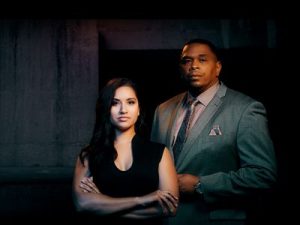
“Reasonable Doubt” explores controversial murder convictions through an objective lens. With their parallel expertise of the law, hosts retired homicide detective Chris Anderson and criminal defense attorney Fatima Silva know that the justice system doesn’t always get it right. As cries of innocence reverberate through prison cells across the country, this series sets out to help families who are desperate for someone to listen to their evidence and theories, convinced that their loved ones were wrongfully convicted of murder. Each episode is an intense and thorough re-examination of a murder case, where the two pore over evidence, interview witnesses, and consult experts previously overlooked by police or barred by the courts to hopefully reveal the truth. Each episode culminates with the gut-wrenching reveal to the family that either brings hope for an appeal, or clarity to accept the guilty verdict.
Series Premiere: April 26, 2017.
Available on Investigation Discovery, Discovery+, Hulu, YouTube TV, Philo and FuboTV. Individual episodes available for a price on Prime Video, Google Play, Vudu and YouTube.
See No Evil
“See No Evil” reveals how the deadliest crimes are solved by the only witnesses that never lie and never forget: surveillance cameras. With more shocking CCTV footage than ever before, “See No Evil” proves there’s nowhere killers can hide.
Series Premiere: February 17, 2015
Available on Investigation Discovery, Discovery+, Hulu, YouTube TV, Philo and FuboTV. Individual episodes available for a price on Prime Video, Google Play, Vudu and YouTube.
Sex & Murder
When you are playing with fire, someone is bound to get burned. In the HLN series “Sex & Murder,” detectives undercover dirty secrets, scandalous sex affairs, online sex addictions, dangerous jealousy, and stunning twisted fantasies which have all led to murder.
Series Premiere: March 9, 2020.
Available on HLN, CNN.com and Hulu.
Signs of a Psychopath
Charm. Narcissism. Lack of empathy. Impulsiveness. Manipulation. Deception. These traits and others are the telltale “Signs of a Psychopath.” This harrowing archive series revisits some of the most dangerous killers in modern history, reviewing news footage—and the words of the killers themselves—to see which terrifying traits each killer exhibited.
Series Premiere: August 23, 2020.
Available on Investigation Discovery, Discovery+, Hulu, YouTube TV, Philo and FuboTV. Individual episodes available for a price on Prime Video, Google Play, Vudu and YouTube.
Sins of the City
“Sins of the City” is a close-ended series that exposes the dark underbelly of a city you thought you knew, by highlighting the mysterious crimes that changed the community forever. Combining informative takeaways and chilling first-hand storytelling, “Sins of the City” focuses on one shocking murder and begins with the discovery of a body as investigators are called to the scene in each hour-long episode. Each episode concludes with a verdict and the impact the case had on the victim’s family, law enforcement, the city, and the people living there.
Series Premiere: May 13, 2021.
Available on TV One, Philo.
Snapped

Oxygen’s ultimate guilty pleasure profiles the fascinating cases of every day, seemingly average moms, wives and girlfriends accused of murder. Did they really do it? And if so, why? Was it a cheating spouse, years of constant abuse or that dirty dish in the sink? “Snapped” attracts millions of fans, including a wide range of celebrities from Anderson Cooper to Kelly Ripa. There are also the spinoff series “Snapped: Killer Couples” and “Snapped: Notorious.”
Series Premiere: August 6, 2004.
Available on Oxygen, Hulu, Peacock, YouTube TV and FuboTV. Individual episodes available for a price on Prime Video, Google Play, Vudu and YouTube.
Still a Mystery
Just because a case is closed doesn’t mean the truth has been revealed. Suicide or murder? Runaway or kidnapping? Accidental or premeditated? “Still a Mystery” re-examines cases where unanswered questions remain. Through original interviews with law enforcement, family members and private investigators, news footage and social media, “Still a Mystery” dissects the evidence and presents new theories in a quest to uncover the truth.
Series Premiere: May 27, 2019.
Available on Investigation Discovery, Discovery+, Hulu, YouTube TV, Philo and FuboTV. Individual episodes available for a price on Prime Video, Google Play, Vudu and YouTube.
Suspicious Minds
Suspicion is contagious. What starts as a tiny spark of doubt focused on one individual can metastasize and cast a shadow on everything you, your community, and ultimately law enforcement thought to be true. “Suspicious Minds” creates a visceral viewing experience where a murder mystery unfolds as a psychological thriller where suspicion and doubt cloud the perceptions of everyone involved.
Series Premiere: October 8, 2020.
Available on Investigation Discovery, Discovery+, Hulu, YouTube TV, Philo and FuboTV. Individual episodes available for a price on Prime Video, Google Play, Vudu and YouTube.
Taking the Stand
“Taking the Stand” tells the story of a crime from the unique lens of the accused as they take the witness stand. Hosted by Dan Abrams, each episode will cover everything from first-hand defendant testimony, juxtaposed with the contentious cross examination to the final verdict. There is a reason that taking the witness stand in your own defense is a gamble that very few criminal defendants ever take. In addition to interviews with key members of the investigation, the series features original video from law enforcement, surveillance camera footage, 911 audio recordings, digital forensic evidence and some exclusive interviews and responses from the defendants themselves, to provide an in-depth look at dozens of raw and real cases.
Series Premiere: January 13, 2022.
Available on A&E, A&E Crime Central, Hulu, Tubi, Sling TV and Philo. Individual episodes available for a price on YouTube.
A Time to Kill
The key to solving the toughest murders lies somewhere in the final 24 hours of a victim’s life. Determined investigators must piece together events to reconstruct the timeline, unlock the motive, and ultimately close in on the killer.
Series Premiere: June 4, 2020.
Available on Investigation Discovery, Discovery+, Hulu, YouTube TV, Philo and FuboTV. Individual episodes available for a price on Prime Video, Google Play, Vudu and YouTube.
To Catch a Smuggler
Homeland Security officers work to stem the flow of illegal contraband at America’s airports, seaports and land border crossings.
Series Premiere: November 27, 2011.
Available on National Geographic Channel, Hulu, ABC. Individual episodes available for a price on Prime Video, Google Play, Vudu and YouTube.
Trafficked With Mariana van Zeller
“Trafficked With Mariana van Zeller” is an original documentary series that explores the complex and dangerous inner-workings of the global underworld, black and informal markets. Each adventure follows Mariana on a mission to follow the chain of custody of trafficked goods, understand how to obtain the contraband, or see the 360-degree view of the trafficking world from the point of view of the smugglers, law enforcement and those caught in the crossfire.
Series Premiere: December 2, 2020.
Available on National Geographic Channel, Hulu, ABC. Individual episodes available for a price on Prime Video, Google Play, Vudu and YouTube.
True Conviction
“True Conviction” explores how homicides are solved on the street and won in the courtroom. Anna-Sigga Nicolazzi, a decorated Brooklyn homicide prosecutor, travels across the country to reveal how the nation’s top prosecutors tackled their toughest cases.
Series Premiere: January 1, 2018.
Available on Investigation Discovery, Discovery+, Hulu, YouTube TV, Philo and FuboTV. Individual episodes available for a price on Prime Video, Google Play, Vudu and YouTube.
Twisted Killers
The most baffling cases. The most bizarre killers. What drives acts of evil? “Twisted Killers” tells the shocking stories of some of America’s darkest, most unusual murderers. Along the way, a trio of criminal experts, including former NYC DA Beth Karas, retired LAPD Homicide Detective Tracey Benjamin and Forensic Psychologist Kate Termini, provide insight and expertise on how these twisted killers were brought to justice.
Series Premiere: January 6, 2022.
Available on Oxygen, Hulu, Peacock, YouTube TV and FuboTV. Individual episodes available for a price on Prime Video, Google Play, Vudu and YouTube.
Twisted Sisters
From a quiet town near the Smoky Mountains, to the sunny skies of St. Petersburg, Florida, stories in this season span the nation, and across multiple different family dynamics. It’s not always the sister who is the culprit of the crime, but sometimes the accomplice, victim, whistle-blower or unintended spy. Each episode of the Khloé Kardashian-produced series “Twisted Sisters” is shrouded in mystery, heartbreak and hidden emotions, proving that where there are family ties, there are also family lies.
Series Premiere: September 3, 2018
Available on Investigation Discovery, Discovery+, Hulu, YouTube TV, Philo and FuboTV. Individual episodes available for a price on Prime Video, Google Play, Vudu and YouTube.
An Unexpected Killer

Each standalone episode takes viewers on a riveting ride that explores a jaw-dropping murder investigation in which detectives discover the killer is someone completely shocking and unexpected. The series takes a deep dive into homicide investigations through captivating interviews with potential suspects, in-depth examinations of the crime scene and re-enactments. “An Unexpected Killer” is produced by Our House Media with Simon Lloyd, Matt Hanna, Samantha De France, Tom Adams, and Carey Zeiser serving as executive producers.
Series Premiere: December 5, 2019.
Available on Oxygen, Hulu, Peacock, YouTube TV and FuboTV. Individual episodes available for a price on Prime Video, Google Play, Vudu and YouTube.
Unsolved Mysteries
Real cases of perplexing disappearances, shocking murders and paranormal encounters fuel this gripping revival of the iconic documentary series.
Series Premiere: January 20, 1987 (NBC); November 13, 1997 (CBS); July 12, 2001 (Lifetime); October 13, 2008 (Spike); July 1, 2020 (Netflix).
Available on Prime Video, Tubi TV, Pluto TV, YouTube, Hulu (for episodes prior to 2020); Netflix (for 2020-present episodes).
Vengeance
HLN’s “Vengeance” franchise is about revenge, betrayal and murder. “Vengeance: Killer Lovers” premiered in March 2019 as the first series under the franchise, followed by “Vengeance: Killer Coworkers” in January 2020. “Vengeance: Killer Families” debuted in September 2021. “Vengeance: Killer Newlyweds” premiered in January 2022.
Series Premiere: March 10, 2019.
Available on HLN, CNN.com and Hulu.
Very Scary People

Hosted by actor and musician Donnie Wahlberg, “Very Scary People” details many of history’s scariest and most notorious characters, through captivating news footage and interviews with people close to the case.
Series Premiere: March 17, 2019.
Available on HLN, CNN.com and Hulu.
World’s Most Evil Killers
This documentary series delves into the gripping real-life stories of the world’s most terrifying and sinister celebrities of the crime world. “World’s Most Evil Killers” gives viewers first-hand accounts as told by detectives involved with the case, journalists who reported on the stories, relatives and survivors. The series examines the triggers that drove the most evil to kill delving into their insatiable appetites for murder and their now chilling legacies. “World’s Most Evil Killers” is produced by Keshet International.
Series Premiere: January 12, 2018.
Available on Reelz.



